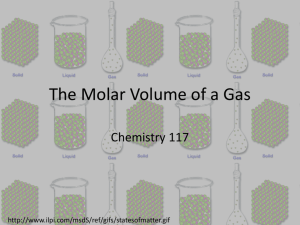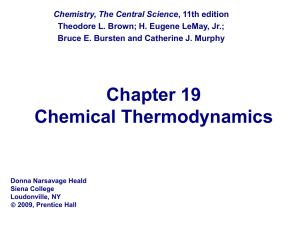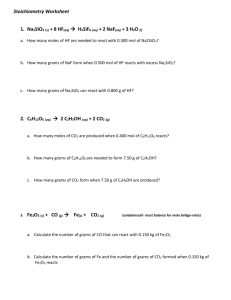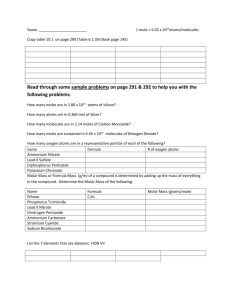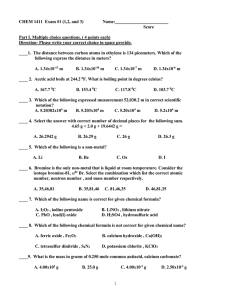1) Given the following equation: 2 KClO3 --
advertisement
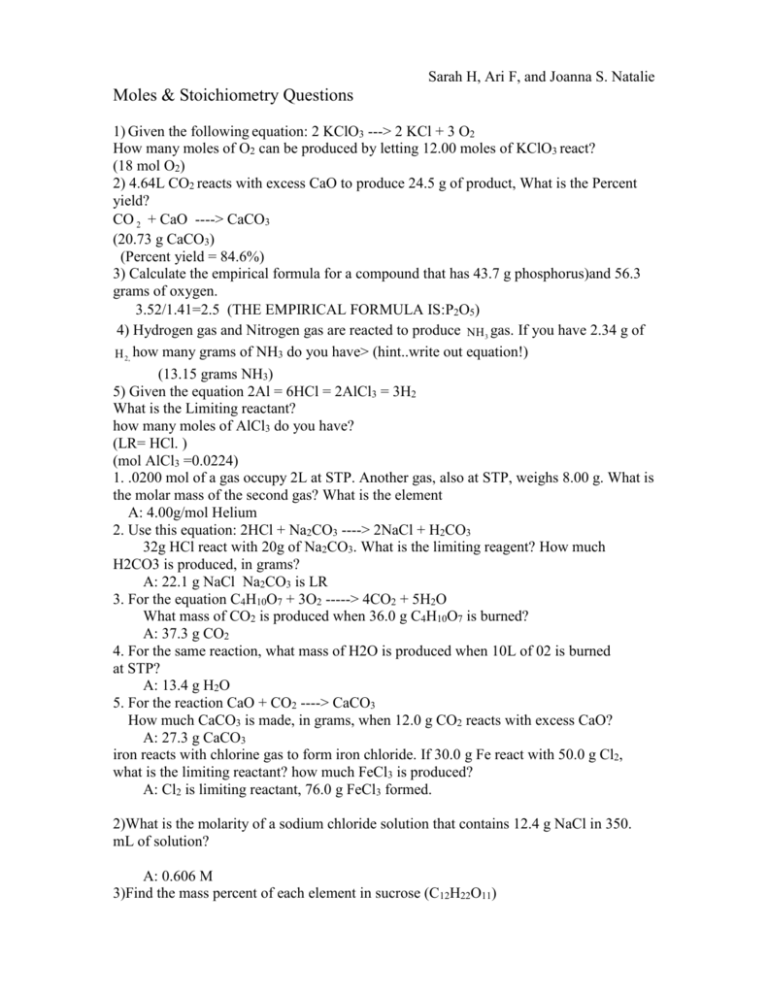
Sarah H, Ari F, and Joanna S. Natalie Moles & Stoichiometry Questions 1) Given the following equation: 2 KClO3 ---> 2 KCl + 3 O2 How many moles of O2 can be produced by letting 12.00 moles of KClO3 react? (18 mol O2) 2) 4.64L CO2 reacts with excess CaO to produce 24.5 g of product, What is the Percent yield? CO 2 + CaO ----> CaCO3 (20.73 g CaCO3) (Percent yield = 84.6%) 3) Calculate the empirical formula for a compound that has 43.7 g phosphorus)and 56.3 grams of oxygen. 3.52/1.41=2.5 (THE EMPIRICAL FORMULA IS:P2O5) 4) Hydrogen gas and Nitrogen gas are reacted to produce NH3 gas. If you have 2.34 g of H 2, how many grams of NH3 do you have> (hint..write out equation!) (13.15 grams NH3) 5) Given the equation 2Al = 6HCl = 2AlCl3 = 3H2 What is the Limiting reactant? how many moles of AlCl3 do you have? (LR= HCl. ) (mol AlCl3 =0.0224) 1. .0200 mol of a gas occupy 2L at STP. Another gas, also at STP, weighs 8.00 g. What is the molar mass of the second gas? What is the element A: 4.00g/mol Helium 2. Use this equation: 2HCl + Na2CO3 ----> 2NaCl + H2CO3 32g HCl react with 20g of Na2CO3. What is the limiting reagent? How much H2CO3 is produced, in grams? A: 22.1 g NaCl Na2CO3 is LR 3. For the equation C4H10O7 + 3O2 -----> 4CO2 + 5H2O What mass of CO2 is produced when 36.0 g C4H10O7 is burned? A: 37.3 g CO2 4. For the same reaction, what mass of H2O is produced when 10L of 02 is burned at STP? A: 13.4 g H2O 5. For the reaction CaO + CO2 ----> CaCO3 How much CaCO3 is made, in grams, when 12.0 g CO2 reacts with excess CaO? A: 27.3 g CaCO3 iron reacts with chlorine gas to form iron chloride. If 30.0 g Fe react with 50.0 g Cl2, what is the limiting reactant? how much FeCl3 is produced? A: Cl2 is limiting reactant, 76.0 g FeCl3 formed. 2)What is the molarity of a sodium chloride solution that contains 12.4 g NaCl in 350. mL of solution? A: 0.606 M 3)Find the mass percent of each element in sucrose (C12H22O11) A: 42.1%C, 6.48% H, 51.4%O 4) In 1.28 mol Ag... a. how many grams of Ag? b. how many Ag atoms? A: 138 g Ag, 7.71 X 10 to the 23 Ag atoms 5) write a balanced equation for the complete combustion of glucose (C6H12O6)... if 72.0 g glucose combusts with excess O2, what is mass of CO2 formed? A: C6H12O6 + 6O2 ---> 6CO2 + 6H2O 106 g CO2

